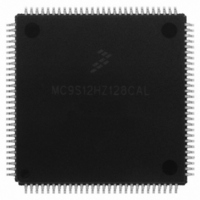MC9S12HZ128CAL Freescale Semiconductor, MC9S12HZ128CAL Datasheet - Page 433

MC9S12HZ128CAL
Manufacturer Part Number
MC9S12HZ128CAL
Description
IC MCU 16BIT 128K FLASH 112-LQFP
Manufacturer
Freescale Semiconductor
Series
HCS12r
Datasheet
1.MC9S12HZ128CAL.pdf
(692 pages)
Specifications of MC9S12HZ128CAL
Core Processor
HCS12
Core Size
16-Bit
Speed
25MHz
Connectivity
CAN, EBI/EMI, I²C, SCI, SPI
Peripherals
LCD, Motor control PWM, POR, PWM, WDT
Number Of I /o
85
Program Memory Size
128KB (128K x 8)
Program Memory Type
FLASH
Eeprom Size
2K x 8
Ram Size
6K x 8
Voltage - Supply (vcc/vdd)
2.35 V ~ 5.5 V
Data Converters
A/D 16x10b
Oscillator Type
Internal
Operating Temperature
-40°C ~ 85°C
Package / Case
112-LQFP
Processor Series
S12H
Core
HCS12
Data Bus Width
16 bit
Data Ram Size
6 KB
Interface Type
I2C, SCI, SPI
Maximum Clock Frequency
50 MHz
Number Of Programmable I/os
85
Number Of Timers
8
Maximum Operating Temperature
+ 85 C
Mounting Style
SMD/SMT
3rd Party Development Tools
EWHCS12
Minimum Operating Temperature
- 40 C
On-chip Adc
10 bit, 16 Channel
Lead Free Status / RoHS Status
Lead free / RoHS Compliant
Available stocks
Company
Part Number
Manufacturer
Quantity
Price
Company:
Part Number:
MC9S12HZ128CAL
Manufacturer:
Freescale Semiconductor
Quantity:
10 000
- Current page: 433 of 692
- Download datasheet (4Mb)
Data reception is double buffered. Data is shifted serially into the SPI shift register during the transfer and
is transferred to the parallel SPI Data Register after the last bit is shifted in.
After the 16th (last) SCK edge:
Figure 14-9
CPOL = 0 and CPOL = 1. The diagram may be interpreted as a master or slave timing diagram because
the SCK, MISO, and MOSI pins are connected directly between the master and the slave. The MISO signal
is the output from the slave and the MOSI signal is the output from the master. The SS pin of the master
must be either high or reconfigured as a general-purpose output not affecting the SPI.
In slave mode, if the SS line is not deasserted between the successive transmissions then the content of the
SPI Data Register is not transmitted, instead the last received byte is transmitted. If the SS line is deasserted
for at least minimum idle time (half SCK cycle) between successive transmissions then the content of the
SPI Data Register is transmitted.
Freescale Semiconductor
•
•
End of Idle State
SCK Edge Nr.
MSB first (LSBFE = 0):
SCK (CPOL = 0)
SCK (CPOL = 1)
SAMPLE I
MOSI/MISO
CHANGE O
CHANGE O
SEL SS (O)
Master only
SEL SS (I)
t
t
t
t
MOSI pin
MISO pin
Data that was previously in the master SPI Data Register should now be in the slave data register
and the data that was in the slave data register should be in the master.
The SPIF flag in the SPI Status Register is set indicating that the transfer is complete.
LSB first (LSBFE = 1):
L
T
I
L
, t
= Minimum idling time between transfers (minimum SS high time)
= Minimum leading time before the first SCK edge
= Minimum trailing time after the last SCK edge
T
, and t
is a timing diagram of an SPI transfer where CPHA = 0. SCK waveforms are shown for
I
are guaranteed for the master mode and required for the slave mode.
tL
MSB
LSB
1
Figure 14-9. SPI Clock Format 0 (CPHA = 0)
2
Begin
Bit 6
Bit 1
3
MC9S12HZ256 Data Sheet, Rev. 2.05
4
Bit 5
Bit 2
5
6
Bit 4
Bit 3
7
Transfer
8
Bit 3
Bit 4
9
10
Bit 2
Bit 5
11
12
Chapter 14 Serial Peripheral Interface (SPIV3)
Bit 1
Bit 6
13 14
End
MSB
15
LSB
16
Minimum 1/2 SCK
tT
for t
Begin of Idle State
T
tI
, t
l
, t
L
tL
433
Related parts for MC9S12HZ128CAL
Image
Part Number
Description
Manufacturer
Datasheet
Request
R
Part Number:
Description:
Manufacturer:
Freescale Semiconductor, Inc
Datasheet:
Part Number:
Description:
Manufacturer:
Freescale Semiconductor, Inc
Datasheet:
Part Number:
Description:
Manufacturer:
Freescale Semiconductor, Inc
Datasheet:
Part Number:
Description:
Manufacturer:
Freescale Semiconductor, Inc
Datasheet:
Part Number:
Description:
Manufacturer:
Freescale Semiconductor, Inc
Datasheet:
Part Number:
Description:
Manufacturer:
Freescale Semiconductor, Inc
Datasheet:
Part Number:
Description:
Manufacturer:
Freescale Semiconductor, Inc
Datasheet:
Part Number:
Description:
Manufacturer:
Freescale Semiconductor, Inc
Datasheet:
Part Number:
Description:
Manufacturer:
Freescale Semiconductor, Inc
Datasheet:
Part Number:
Description:
Manufacturer:
Freescale Semiconductor, Inc
Datasheet:
Part Number:
Description:
Manufacturer:
Freescale Semiconductor, Inc
Datasheet:
Part Number:
Description:
Manufacturer:
Freescale Semiconductor, Inc
Datasheet:
Part Number:
Description:
Manufacturer:
Freescale Semiconductor, Inc
Datasheet:
Part Number:
Description:
Manufacturer:
Freescale Semiconductor, Inc
Datasheet:
Part Number:
Description:
Manufacturer:
Freescale Semiconductor, Inc
Datasheet:











